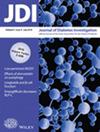Causal association between cystatin C and diabetic retinopathy: A two-sample Mendelian randomization study
Abstract
Objective
To explore the causal relationship between cystatin C levels and different stages of diabetic retinopathy through Mendelian randomization (MR).
Methods
The MRC Integrative Epidemiology Unit provided the Genome-wide association studies (GWAS) data related to cystatin C (exposure). GWAS data for outcomes [DR, proliferative diabetic retinopathy (PDR), severe non-proliferative background diabetic retinopathy (SNPBDR)] were sourced from the FinnGen. Adopted Inverse Variance Weighting (IVW), MR-Egger regression MR-PRESSO, Weighted Median, Constrained Maximum Likelihood and Model Averaging (cML-MA), Weighted model, Radial MR, and MR-Lasso to estimate the causal relationship between cystatin C and diabetic retinopathy. We conducted multivariable MR analysis to evaluate the independent causal effects of cystatin C levels on diabetic retinopathy.
Results
Based on the IVW method, we observed a causal relationship between cystatin C and diabetic retinopathy [odds ratio (OR)random effect = 1.137, 95% confidence interval (CI): 1.035–1.250]/PDR (ORrandom effect = 1.123, 95%CI: 1.004–1.255)/SNPBDR (ORfixed effect = 2.002, 95%CI: 1.343–2.986). Consistent findings were obtained through the cML-MA method. Cochran's Q test suggested the presence of heterogeneity between the cystatin C level and instrumental variables in relation to diabetic retinopathy and proliferative diabetic retinopathy, respectively. After adjusting for outliers using MR-PRESSO and Radial MR, it was observed that the statistical significance of the association between cystatin C level and diabetic retinopathy persists. Reverse MR analysis indicated that genetically related SNPBDR may influence the cystatin C level. In multivariable MR analysis, there were indications suggesting a causal relationship of cystatin C with the risk of DR/PDR/SNPBDR adjusting for confounders.
Conclusions
This study utilizes Mendelian randomization analyses to establish a causal relationship between cystatin C and diabetic retinopathy, and reveals the impact of cystatin C on the risk of diabetic retinopathy, thus providing new evidence for clinical intervention of diabetic retinopathy.


 求助内容:
求助内容: 应助结果提醒方式:
应助结果提醒方式:


